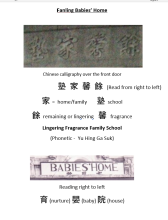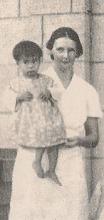Also known as Ao Garden (鰲園), this mansion was constructed in 1928 by Lai Yue-hing, a returned overseas Chinese from Chile. The building was a two-story Western-style villa with a fountain in front and two adjacent Chinese-style bungalows next to it.
In 1940 the mansion was rented by Mildred Dibden as the Fanling Babies Home until 1966 when the operation was moved to Tai Po.
The mansion was subsequently abandoned but was a popular filming location for local movies through the 1970s and 1980s incl A Lotus for Miss Quon (1966), Dirty Tiger, Crazy Frog (1978), Snake Deadly Act (1980), Legend of a Fighter (1982), Angel II (1988), Killer Angels (1989), Shadow of China (1989),
The building was demolished in 1992 to make way for an industrial building called World Trade Square.
See Aldi's comment below for further information about the building and surrounding area.


Comments
Thanks Phil, good to see some
Thanks Phil, good to see some photos of this building.
A few dates from the Fanling Babies Home History web page:
Fanling Babies Home
One of the best collections of its multiple appearances on screen can be found here.
Tai Po Babies Home
The building still exists and is used as a school at Hong Chi Pinehill Village. When the charity which operated the Babies Home left Hong Kong they donated their land at Tai Po to The Hong Kong Association for the Mentally Handicapped which was later renamed Hong Chi Association. Hong Chi is one of Hong Kong's largest NGOs and operates many special schools and centres through out Hong Kong. I was the Chairman of Hong Chi Assocation from 1987 to 2004.
Fanling babies Home
Hi John
As far as I am aware this actual building was located in On Lok Tsuen in Fanling, not Taipo. Perhaps you are confusing it with the building they used when they moved to Taipo in 1966?
The film stills don't really do it justice, but if you click on the other link I provided above you can see what it looked like in its full former glory.
Regards
Phil
Hi Phil,
Hi Phil,
Thank you for your email. I am not confused. I am talking about the building in Tai Po not Fanling.
Regards,
John
Hi John
Hi John
Understood. But this page refers to the original mansion in Fanling which was demolished in 1992 and NOT the one in Taipo
Thanks
Phil
Opening date
I've updated the opening date for the Fanling home according to @dibden's uploaded brochure attached below. It would be nice to know the history of the building before the Fanling Babies Home moved in - such as who the original owners were and when it was built etc.
3rd Commando Brigade and Fanling Babies Home
3rd Commando Brigade arrived in Hong Kong on 12 and 13 September 1945. No. 5 Commando was based at Fanling with their HQ at Lena Lodge. The men formed a good rapport with the Fanling Babies Home.
From the book Its All In the Mind: The Life and Legacy of Larry Stephens mention is made of this strong connection.
Yip family
thanks @dibden, that's more information than I ever expected. Is there any mention of the build date for the property?
Fanling Childrens Home
As an Army child in 1952, aged 12 years, our family was posted to Hong Kong in the New Territories, not far from Fanling. Our Army Padre's wife ran our Youth Club and one day she set up a visit for the girls to visit the Children's Home, taking all kinds of gifts with us for the children. We were told before our visit, to understand that we would see far more girls than boys in the Home, as it was the custom for poor Chinese families to give up their baby girls as they could not afford the marriage costs that fell on the girl's family. The total children and babies at the home at that time was 130 girls and 5 boys! The younger children loved all the attention that day, with lots of hugs and hand holding. The older girls were a little wary of we 'confident' British girls but they had been taught some English so we all had a good time in the end. I am collecting photos off the internet that will compliment my memories of our time in Hong Kong but it’s time consuming and I am not in a position yet to send it all in to Gwulo. My father was in the Royal Engineers which I believe were based at Tang Lin? I went to school from New Territories each day by army truck to Taipo Market station and then onwards by steam train into the station at Kowloon (which was at that time right by the clock tower near the Star Ferry. We then used to walk along Nathan Road to Melbourne Road and the Minden Row Mixed services school. When we first arrived in Hong Kong we were housed in the Melbourne Hotel until our quarters were completed out at Sekkong, New Territories. There was an air base about 2 miles from the Sekkong quarters, where we went many times to the swimming pool and cinema. They used to fly some of the first jet engine planes over the top of our quarters each day to patrol the border with China. As I said earlier, I have very clear memories from this time and am typing it all out with the relevant photos in the not too distant future. Regards. Valerie Eggleton
Latest Posting - Supplementary Information
A nice story of the visit to the Children's Home.
Here is a list of 1950 Military Installations Closed Areas. The Camp of the Royal Engineers would likely have been at Tai Lam. Probably Tai Lam Camp. Tanglin Barracks was in Singapore.
To get to school, the "Melbourne Road" referred to maybe Middle Road. One would have passed by an open-air car park and children's park. The Melbourne Hotel on Mody Road, just off Nathan Road was close by to Minden Row School.
Lai Yue Hing Tong brief history
In 1914 some Chinese businessmen raised enough capital to buy farmland from Fanling landlords and develop it into a garden villa area. This became On Lok Tsuen (Village) and it was completed in the early 1920s, arranged with neat horizontal and vertical streets and waterways. It had many ornate mansions and villas that combined Chinese and Western architectural styles, along with gardens, farms and orchards.
Because many wealthy businessmen* settled in On Lok Village, it became a target for thieves and robbers, and residents of new properties in the village had to pay a fee of NT$2000 for the defence of the village during the 1920s.
Lai Yue Hing Tong (Hall), which became the Fanling Babies’ Home, was built in 1928. It was named after its owner, a Chinese in his fifties who had returned from Chile with a bit of capital. It was a two-story Western-style villa with a fountain/pool in front of the house and two Chinese-style bungalows in its grounds. Each bungalow had 8 rooms and kitchen facilities.
The owner, Lai Yue Hing, had intended the mansion to be the ancestral home to contain all his relatives, hence the two other houses in the grounds. The main building had 5 large rooms and 3 smaller ones on the ground floor; upstairs it had 7 bedrooms and verandas, with adjoining dressing rooms. Surrounding the house were decorative and well-stocked gardens.
The owner's sons had gone abroad to study however, and he fully expected them to go into business overseas, so it was all bigger than he needed. He therefore decided to rent the property out, and following negotiations with Mildred Dibden in 1940, the mansion became the Fanling Babies’ Home.
Sadly towards the end of the war the owner died of cholera. His wife sold the property to the China's Children Fund. This enabled it to continue as the Fanling Babies' Home until 1966.
In 1966 The Fanling Babies’ Home moved to Taipo.
The mansion remained empty but from the 1950s the area became popular for film locations due to its large numbers of decorative mansions and villas. This carried through to the 70s and 80s, with ten films including Water Chicken Fighting Tiger, Snake Walk, Funny Times, Fearless, Dragon in China being made on this site alone.
Fanling was developed as a new town in the 1980s, the government ordained that On Lok Village was being re-zoned into "industrial" and all of the residents had to move out. According to HK news, Apple Daily, at some point the Fanling site was converted for use as a dyeing factory (link lost). On Lok Tsuen Industrial Area became one of the major industrial areas in Hong Kong.
The building was demolished in 1992.
* There were at least 6 returnees from the Americas settling here at this time (Chile, Peru, Panama and the USA).
Sources:
The Yip Family of Amah Rock by Jill Doggett
Chinese Wikipedia
Hong Kong Movie Tours